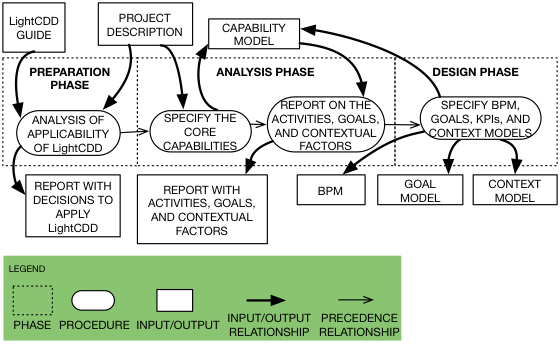Light CDD
Light CDD is a simplified version of Full CDD to support the capability-based design of the startups. It reduces the set of modelling constructs and guidelines of Full CDD to facilitate its adoption by entrepreneurs. Yet, Light CDD is expressive enough for the entrepreneurial purposes and, at the same time, compatible with CDD methodology. As such, the Light CDD incorporates the context modelling, goal modelling and business process modelling method components. The concepts of the Light CDD is adapted from the capability meta-model, which the Full CDD also relies on. This is depicted in the next picture.

Light CDD consists of procedures that are classified into three phases, namely preparation, analysis and design, which are defined in the following picture.

Preparation phase: The entrepreneurs are provided with a Light CDD guide. The guide consists of the information, what enterprise modelling in general is, and how this could help to improve their case. Moreover, it includes the meta-model, the definitions of the CDD terms in a tabular form as well as a simple example, where the method is used.
Analysis phase: The core proposition of the business idea is expressed as a capability. Then, key activities regarding the implementation of the capability are enumerated. Next, the goals are listed that needs to be fulfilled. Following that, the contextual factors influencing the objectives or the key activities are analyzed. The gained information might require an update in the core proposition of the capability or result in additional capabilities, which is why the analysis phase may be iterated more than once.
Design phase: The key activities are documented as business process models and objectives are captured as goal models. The key performance indicators (KPI) are added to the goals. Based on the capabilities, the business process models and goal models are related to the context models, which represent the contextual constraints of the business environment.
Substantial differences between the Light CDD and the Full CDD are represented in the following table. Full CDD is supported by a number of tools including the Capability Design Tool (CDT), Capability Context Platform (CCP), Capability Pattern Repository (CPR) and Capability Delivery Navigation Application (CNA). For the Light CDD, the focus is on the enterprise modelling phase, hence the CDT – a graphical modelling tool for capability design – is required for the method application. The reuse of capability design method component (pattern modelling) is excluded, since the business idea is expected to be unique and as such no best practices in the application field may exist. The runtime delivery adjustment method component (adjustments modelling) is also excluded due to its strong focus on the implementation of the business idea, which is the run-time aspect. Light CDD applies enterprise modelling method component in part (goal modelling, business process modelling) and context modelling as a whole.
Click on the link for a publication about the Light CDD.